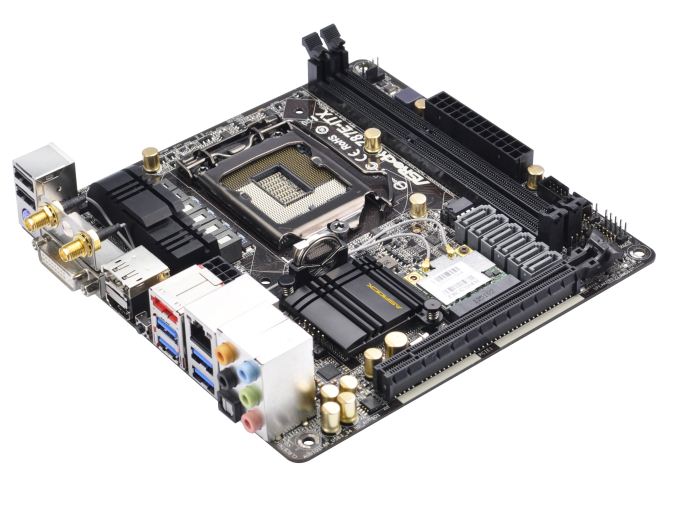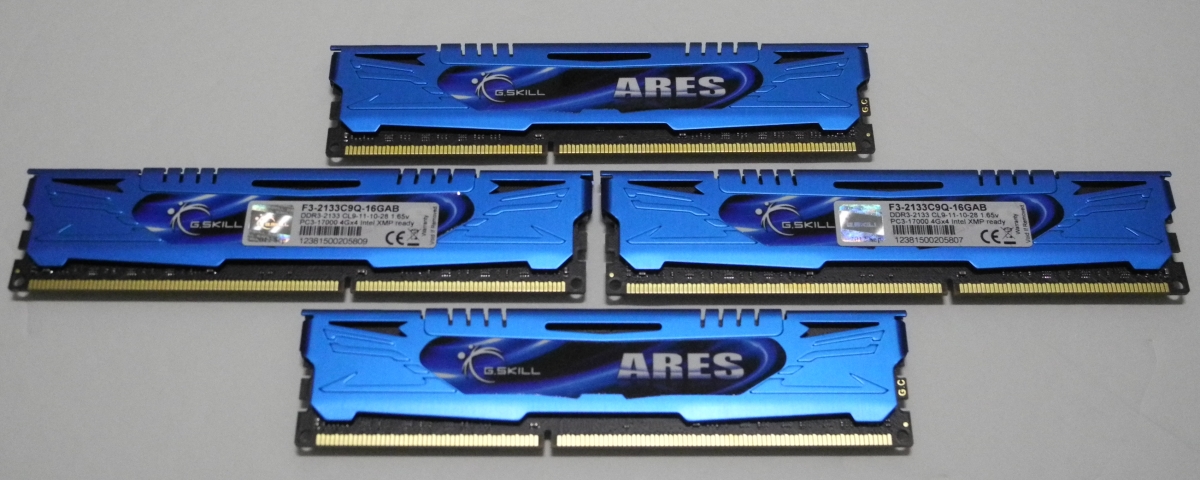Intel's Haswell - An HTPC Perspective: Media Playback, 4K and QuickSync Evaluated
by Ganesh T S on June 2, 2013 8:15 PM ESTTestbed and Software Setup
Instead of going for the usual high end CPU (77W / 95W TDPs), we have opted for the Core i7-4765T for today's review. This is a 35W TDP CPU with four cores / eight threads, expected to retail with a MSRP of $303. Intel has a number of GPU configurations doing the rounds at Haswell launch. The i7-4765T sports the HD 4600 GPU, and it is the best GPU available in a LGA 1150 configuration (The Iris Pro 5200 GPUs are reserved for BGA configurations and unavailable to system builders).
The table below presents the hardware components of our Haswell HTPC testbed
| Haswell HTPC Testbed Setup | |
| Processor | Intel Core i7-4765T - 2.00 GHz (Turbo to 3.0 GHz) |
| Intel HD Graphics HD4600 - Up to 1200 MHz | |
| Motherboard | ASRock Z87E-ITX mITX |
| OS Drive | Seagate 600 SSD ST240HM000 240GB |
| Memory | G.SKILL Ares Series 8GB (2 x 4GB) SDRAM DDR3 2133 (PC3 17000) F3-2133C9Q-16GAB CAS 9-11 -10-28 2N |
| Optical Drive | ASUS 8X Blu-ray Drive Model BC-08B1ST |
| Case | Antec Skeleton ATX Open Air Case |
| Power Supply | Antec VP-450 450W ATX |
| Operating System | Windows 8 Professional x64 |
| Displays / AVRs | Onkyo TX-SR606 + Acer H243H |
| Pioneer Elite VSX-32 + Sony Bravia KDL46EX720 | |
| Sony XBR-84X900 | |
| Seiki Digital SE50UY04 | |
The ASRock Z87E-ITX board comes with a Broadcom-based 802.11ac 2T2R solution. Connected to a Buffalo WZR-D1800H 802.11ac router, I was able to consistently obtain 173 Mbps of practical throughput. Streaming Blu-ray ISOs over Wi-Fi from a NAS worked without issues. The board was very simple to get up and running and given its form factor and the CPU currently installed, I hope to migrate it to a passive HTPC build soon.
The Haswell platform officially supports DDR3-1600. Towards this, we obtained a 16 GB DDR3-2133 Ares kit from G.Skill for our testbed. The Ares kit supports XMP 1.2 and the ASRock Z87E-ITX had it running at 2133 MHz flawlessly on first boot. However, we made sure to run the memory at the suggested 1600 MHz in order to obtain results consistent with what an average system builder (non-overclocker) would obtain. The Ares kit makes it possible to study HTPC behaviour from a memory bandwidth perspective, but we will not cover that aspect in this launch piece.
The software setup for the Haswell HTPC testbed involved the following:
| Haswell HTPC Testbed Software Setup | |
| Intel Graphics Driver | 9.18.10.3107 (Version on ASRock Motherboard DVD) |
| Blu-ray Playback Software | CyberLink PowerDVD 13 |
| Media Player | MPC-HC v1.6.7.7114 |
| Splitter / Decoder | LAV Filters 0.57 |
| Renderers | EVR / EVR-CP (integrated in MPC-HC v1.6.7.7114) |
| madVR v0.86.1 | |
The madVR renderer settings were fixed as below for testing purposes:
- Decoding features disabled
-
Deinterlacing set to:
- automatically activated when needed (activate when in doubt)
- automatic source type detection (i.e, disable automatic source type detection is left unchecked)
- only look at pixels in the frame center
-
Scaling algorithms were set as below:
- Chroma upscaling set to SoftCubic with softness of 100
- Luma upscaling set to Lanczos with 4 taps with anti-ringing filter left deactivated and scale in linear light left unchecked / DXVA2
- Luma downscaling set to Lanczos with 4 taps with anti-ringing filter left deactivated and scale in linear light left unchecked / DXVA2
-
Rendering parameters were set as below:
- Automatic fullscreen exclusive mode was used
- CPU and GPU queue sizes were set to 32 and 24 respectively
- Under exclusive mode settings, the seek bar was enabled, switch to exclusive mode from windowed mode was delayed by 3 seconds and 16 frames were configured to be presented in advance. The GPU flushing modes were set to default
- Smooth motion was left disabled
- The 'trade quality for performance' settings were left at default (i.e, linear light was left disabled for smooth motion frame blending and custom pixel shader results were stored in 16-bit buffers instead of 32-bit)
Unlike our Ivy Bridge setup, we found the windowed mode to be generally bad in terms of performance compared to exclusive mode.
MPC-HC and LAV Filters settings were altered from the defaults as below for testing purposes:
- DirectShow Video Output was configured as EVR / EVR-CP / madVR under Options > Playback > Output
- All internal source and transform filters were disabled under Options > Internal Filters
- Under Options > External Filters, LAV Splitter, LAV Audio Decoder and LAV Video Decoder were added as Preferred filters
- LAV Audio Decoder was set to bitstream all applicable formats
-
LAV Video Decoder were altered from the defaults as below
- Hardware Acceleration was set to DXVA2 Native / QuickSync / None depending on the aspect being tested. UHD (4K) was enabled in all the cases
- Deinterlacing mode was set to 'Aggressive'












95 Comments
View All Comments
ganeshts - Monday, June 3, 2013 - link
Haven't come across a 4Kp60 sample yet. All the stuff on YouTube is at a max. of 30 fps, and I have some samples sourced from other platforms that are QuadFHD at 30 fps. Please pass on any 4Kp60 clips that you have.I know there are two crazy scene encodes with 4Kp50 (Crowd Run 2160p) and a 250 Mbps one (Ducks Take Off). No hardware decoder I have seen has been able to handle either properly. So, I doubt 4Kp60 is going to work :| That said, if I get a chance, I will definitely evaluate the Iris / Iris Pro.
madwolfa - Monday, June 3, 2013 - link
Why do you still need 23.96 support since "Smooth Motion" feature in MadVR? I couldn't care less now...Dug - Monday, June 3, 2013 - link
Because not everyone can, wants to, or even knows what MadVR is. Never mind setting it up properly.HOSH - Monday, June 3, 2013 - link
Personally this is going in the right direction, but I am wondering what low power settings we could use with the Core i7-4750HQ or the Core i7-4770R in an Mini-ITX HTPC style board since they both have the Iris Pro 5200. From reading the reviews here the Iris Pro 5200 should be closer to what NVIDIA or AMD currently has to offer in the HTPC discrete graphics, but on die for a cleaner system.Aikouka - Monday, June 3, 2013 - link
Is it worthwhile to assume that the poor QuickSync performance is just a software problem? I've been interested in gaining QuickSync support, but the performance presented isn't that enticing.ganeshts - Monday, June 3, 2013 - link
Very much possible. I am going to evaluate a driver downgrade to see if the issue is in the latest drivers.superjim - Monday, June 3, 2013 - link
Why do we need an i7 for HTPC duty? A 45W Core 2 Duo or Athlon II system is plenty using a 6570/430 and up GPU. Sure it uses more power but that's hardly a problem (both in money and heat). What is the usage scenario for an HTPC that needs an i7?Aikouka - Monday, June 3, 2013 - link
They probably didn't have access to a lower-end Haswell processor... especially since Intel hasn't released the i3 Haswell processors yet.superjim - Monday, June 3, 2013 - link
Makes sense but even an i3 is overkill for an HTPC as another commenter suggested. I think Trinity has a pretty tight grip on the bang-for-the-buck HTPC right now. Richland will only make that better.Penti - Monday, June 3, 2013 - link
It really depends on the amount of post processing done on the HEPC, a Trinity/Richland or Intel with integrated graphics or something like a HD6450 really isn't enough for all. Obviously a fast CPU is good as a fallback when there is no hardware acceleration too.